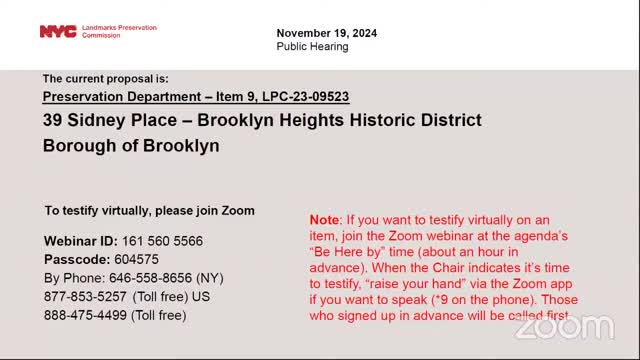Historic Brooklyn Row House Set for Thoughtful Restoration
November 19, 2024 | Land Preservation Commission, New York City Board & Committees, New York City, New York County, New York
This article was created by AI summarizing key points discussed. AI makes mistakes, so for full details and context, please refer to the video of the full meeting. Please report any errors so we can fix them. Report an error »

In a recent government meeting, significant discussions centered around the proposed alterations to two historic properties in Brooklyn Heights, highlighting the ongoing tension between preservation and modernization in historic districts.
The first proposal involved the facade of 39 Sydney Place, which has undergone significant architectural changes since its original construction. Testimonies from various stakeholders, including architectural historians and local associations, emphasized the importance of preserving the existing facade, which reflects a notable period in the area's architectural history. Critics of the proposed changes argued that the new design would erase the building's historical significance and disrupt the character of the Brooklyn Heights Historic District. They pointed out that the current facade, dating back to 1917, is a well-executed example of early 20th-century conversions and should be preserved rather than altered to fit a different style.
Judy Stanton from the Brooklyn Heights Association expressed strong opposition to the application, citing the lack of detailed plans and the potential loss of historical elements. Architectural historian Andrew Dolcart described the building as a \"superb example\" of the redesigned row house movement, urging the commission to reject the proposal for a faux Greek Revival facade that would misrepresent the building's history.
In contrast, the second proposal for 20 Remsen Street received a more favorable reception. This application seeks to remove a non-historic fourth floor added in the 1960s and restore the building to its original three-story height. The plan includes a contemporary artist studio on the roof, designed to be minimally visible from the street. Testimonies from the Victorian Society of New York and the Historic Districts Council praised the proposal as a thoughtful restoration that respects the building's historical context while accommodating the needs of its current occupants.
Commissioners expressed support for the second proposal, noting its potential to enhance the streetscape and restore the building's original character. They emphasized the importance of maintaining the historic integrity of the neighborhood while allowing for modern adaptations that reflect the lifestyle of contemporary residents.
Overall, the discussions underscored the complexities of balancing historic preservation with the evolving needs of urban living, as stakeholders grapple with how best to honor the past while accommodating the future. The commission is expected to deliberate further on both proposals, weighing the merits of preservation against the desire for modernization.
The first proposal involved the facade of 39 Sydney Place, which has undergone significant architectural changes since its original construction. Testimonies from various stakeholders, including architectural historians and local associations, emphasized the importance of preserving the existing facade, which reflects a notable period in the area's architectural history. Critics of the proposed changes argued that the new design would erase the building's historical significance and disrupt the character of the Brooklyn Heights Historic District. They pointed out that the current facade, dating back to 1917, is a well-executed example of early 20th-century conversions and should be preserved rather than altered to fit a different style.
Judy Stanton from the Brooklyn Heights Association expressed strong opposition to the application, citing the lack of detailed plans and the potential loss of historical elements. Architectural historian Andrew Dolcart described the building as a \"superb example\" of the redesigned row house movement, urging the commission to reject the proposal for a faux Greek Revival facade that would misrepresent the building's history.
In contrast, the second proposal for 20 Remsen Street received a more favorable reception. This application seeks to remove a non-historic fourth floor added in the 1960s and restore the building to its original three-story height. The plan includes a contemporary artist studio on the roof, designed to be minimally visible from the street. Testimonies from the Victorian Society of New York and the Historic Districts Council praised the proposal as a thoughtful restoration that respects the building's historical context while accommodating the needs of its current occupants.
Commissioners expressed support for the second proposal, noting its potential to enhance the streetscape and restore the building's original character. They emphasized the importance of maintaining the historic integrity of the neighborhood while allowing for modern adaptations that reflect the lifestyle of contemporary residents.
Overall, the discussions underscored the complexities of balancing historic preservation with the evolving needs of urban living, as stakeholders grapple with how best to honor the past while accommodating the future. The commission is expected to deliberate further on both proposals, weighing the merits of preservation against the desire for modernization.
View full meeting
This article is based on a recent meeting—watch the full video and explore the complete transcript for deeper insights into the discussion.
View full meeting
